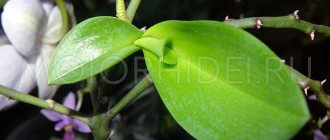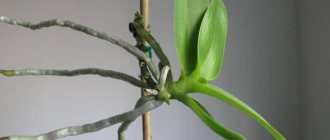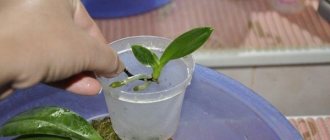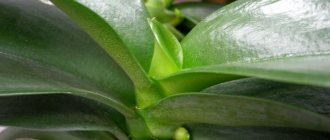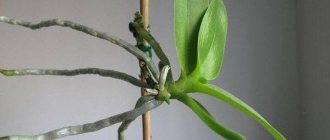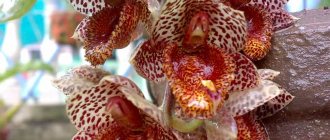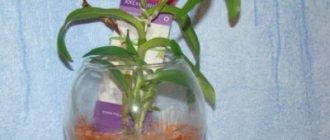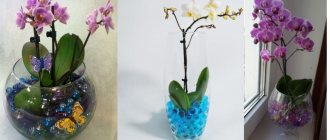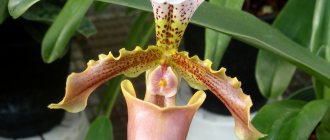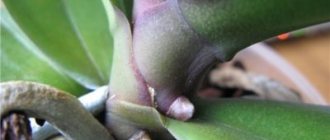Description of appearance and photo
The baby is a shoot on a peduncle, which has its own root system, leaves, and sometimes even its own peduncle.
The baby grows and develops on the mother plant within 5–6 months. This time is necessary for it to form its root system, leaves, and gain strength for independent life.
Difficulties
A difficult task for a gardener can be situations with a child whose roots do not grow. Causes:
- lack of lighting;
- unsuitable fertilizer;
- lack of moisture.
First they eliminate the cause, then they try to grow the roots. The following methods of growing rhizomes are known:
- Floating escape on foam.
- Hanging the sprout above the ground.
- Creating a greenhouse in a plastic cup with a hole, at the bottom of which drainage is placed, then moss (sphagnum) rolled into a ball and tied with thread, soaked for half an hour in water. A support for the baby is built outside the glass so that the sprout does not touch the moss.
You can also grow roots in children who grow on the mother orchid. Fastening wet moss to the base of the peduncle helps the shoots to develop roots. The rhizome grows over a period of 3-6 months.
Purpose of appearance
The main purpose of the appearance of a baby is reproductive; the plant thus produces offspring and tries to prolong life. Propagation of orchids by children appearing on the arrow is one of the most popular methods of propagating certain types of orchids at home among gardeners.
Before raising a baby, you need to know what to do when an orchid has released a peduncle, and also how to force an orchid to produce several peduncles if it is stubborn and does not produce even one.
What to do if it doesn’t take root?
In rare cases, it happens that a baby does not take root or does not take root in a new place. Then you need to place the orchid shoot in water. Moreover, only a small part of the root system is placed in water. The rest should be on the surface. It can take up to two weeks to grow the root system.
Propagating an orchid by children is not so difficult. The main thing is to carefully separate the shoot from the adult plant and provide it with further competent care. Do not forget that it is not recommended to separate the baby growing near the root system.
Conditions of appearance
In order for babies to form on the arrow of the orchid, after the plant has finished blooming, it is necessary not to cut off the peduncle completely (read about what to do with the arrow when the orchid has already bloomed). It should simply be shortened, the cut point is 2 cm above the “sleeping” bud. In addition, the plant must be provided with a sufficient amount of intense light, which awakens the bud from sleep, and a high temperature regime.
Reference. If after flowering the arrow is left untouched, the orchid can “dry” it completely in order to save nutrients.
Find out in this material whether you should worry if the peduncle of an orchid has dried up and what to do in such a situation.
The cut must be made with a disinfected pruner. This must be done with great care, as the trunk and leaves of the plant can easily be damaged. In addition, if any hangnails or roughness remain, this can lead to the orchid becoming infected with infectious diseases. It is recommended to treat the cut area with cinnamon or crushed activated carbon.
A visual video on how to stimulate the appearance of a baby on a peduncle after the orchid has bloomed:
Step-by-step instructions on how to get offspring
An orchid will begin to form “offspring” only if it is provided with proper care and optimal conditions for reproduction are created.
- Prepare a peduncle that has faded but is still green: it must be trimmed, 2 cm away from the second “dormant” bud from the bottom.
- Treat the cut area with crushed activated carbon tablets or cinnamon.
- Provide the plant with differences in night and day temperatures (+15C-+30C). To do this, you can place the orchid on the windowsill or on the veranda of your house.
- Watering should be scanty: the stressful state that the epiphyte will experience will make it possible to awaken the “sleeping” buds.
- Spray the epiphyte daily with a spray bottle, thereby ensuring a high level of humidity in the room.
- Promote air access to the orchid roots: make additional holes in the walls of the pot.
- Provide access to a large amount of intense diffused light to the epiphyte (south and southeast windows).
- The orchid should be systematically fed with fertilizers high in nitrogen.
Reference. You can often find information about stimulating “dormant” buds with hormonal drugs so that the flower stalk throws out the baby. One of the most famous such drugs is cytokinin paste. Having opened the bud, it should be smeared with this paste on top.
This procedure can be repeated 3 – 5 times. Babies may appear within 2-3 months, but a lateral arrow may also appear from a “dormant” kidney. But it should be remembered that this method of raising children greatly depletes the mother plant.
How to separate from mother?
What to do after a shoot has appeared on the peduncle and given roots? When the roots reach 5–6 cm, the baby can be transplanted into the ground. But first you need to properly separate it from the mother plant.
Prepare everything necessary for planting the baby: substrate (base - coniferous tree bark), expanded clay, sphagnum moss, small plastic pot, disinfected pruning shears, cinnamon or activated carbon.- Cut off the baby with part of the peduncle on which the baby developed (a gap of 1.5 cm).
- Dry the cut area for half an hour, then treat it with cinnamon or activated carbon.
- The new orchid is placed in a pot in the center (a prerequisite is the presence of holes in it for drainage and aeration), the bottom of which is covered with drainage.
- Holding it by the root collar, the container should be filled with moistened substrate.
- The top layer of the substrate should not be compacted. To avoid voids in the pot, you need to knock on its walls.
- You can sprinkle the top layer of the substrate with sphagnum moss.
Some gardeners recommend placing the pot with the already separated plant in a “greenhouse”: cover it with a transparent plastic bag, which should be removed for some time every day for ventilation.
We invite you to watch a video on how to properly separate a baby orchid from a peduncle:
Recommendations for transplantation
- The most favorable time for planting shoots is the warm season.
- The temperature for transplanting an orchid shoot is +20 – +25°C, suitable air humidity is 50–60%.
- Flower growers choose the place where the orchid shoot is transplanted depending on the presence of roots.
- If the baby has grown roots, it is planted in the substrate. In the absence of rhizomes - in polystyrene foam or a greenhouse.
If more than one child from a parent plant is cut off and replanted at one time, this can destroy the parent.
How to care for a flower?
In order for an orchid to give birth to “offspring” in the form of children, it is important for it to provide the necessary conditions for this: a large amount of light, high temperatures during the day and low at night (+15C - +30C), high humidity levels, systematic application of nitrogenous fertilizers, which can be purchase at a specialized flower shop.
When the peduncle has already released the baby, the plant should be moved to a warm and more shaded place. It is also necessary to provide it with systematic watering according to the basic rule: as the substrate dries out. On average, the interval between waterings can be 5 – 10 days.
After every second watering, it is recommended to continue to apply fertilizers with a high percentage of nitrogen. It is better if this feeding is foliar, that is, the baby itself will be irrigated from a spray bottle. Sometimes you can irrigate the plant in the shower, which will only contribute to the formation of healthy and strong children.
After the baby is cut from the peduncle, it must be cut off completely, since it will no longer produce buds or new shoots. And the plant needs to be at rest for some time - to restore its strength.
Caring for young offspring
Watering should not be done during the first days, since the young orchid was planted in a damp substrate. You can irrigate the plant with warm water from a spray bottle. The first watering is only 4 days after planting. Keep in a room with high humidity, high temperature (not lower than +25C) and a sufficiently large amount of diffused sunlight.
Such “greenhouse” conditions must be maintained throughout the year: the plant must grow 3–4 leaves, and the roots must reach the bottom of the pot. But we should not forget about daily ventilation of the plant.
In the video you can see how to care for baby orchids:
Growing on a cut peduncle
Some gardeners prefer to grow babies on a cut peduncle. To do this, the flowering stem must be cut off at the base. After this, it is cut into several parts. The size of each fragment should be 3–4 cm. In this case, in the center of each piece there should be a “sleeping” bud.
After the peduncle has been cut into separate fragments, all the resulting sections should be sprinkled with activated charcoal or charcoal powder. In this case, the resulting cuttings must be placed in damp sphagnum moss or in a mini-greenhouse. The cut peduncle should be at a temperature of +25…+28 °C. It is also necessary to maintain a constant humidity level in the mini-greenhouse or room. Only in this case will the prepared cuttings be able to germinate successfully.
Problems with the appendage
Stayed on the mother shoot for a long time, but never produced roots
In this case, you can still give more time for the shoot to take root. If there are no shifts, then you can try using pre-wetted sphagnum moss to wrap the place where the baby is attached to the frog, securing it with a bandage or strong thread. Every day for a month it is necessary to irrigate the moss with water with the addition of the drug “Kornevin”.
To create greenhouse conditions, the moss nest can be additionally wrapped in cling film, but do not forget to remove it for a while every day in order to prevent the plant from rotting.
Placed on a curved arrow
Some types of orchids have quite flexible flower stalks. In the case of flexible and curved peduncles, the baby does not need to be trimmed. The arrow of the orchid with the baby is simply pulled to a pot with bark so that the roots of the young plant go into the ground. The peduncle itself is fixed to the wall of the pot using wire. In such cases, the baby develops especially quickly, as it receives nutrition from the mother plant and from its own root system. There is no need to use a greenhouse here.
All the main points on raising children and separating them from their mother, the orchid, were outlined above. It remains to add that the obligatory components of success in this troublesome, but still rewarding task are love, patience and care. With these feelings and qualities, you can easily cope with the task and not be afraid, but look forward to the appearance of a shoot on the peduncle of your favorite orchid.
